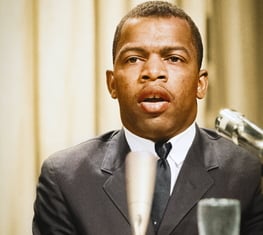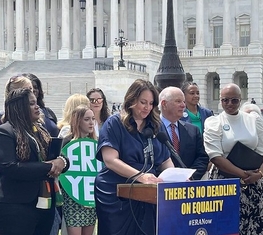LWVUS Programs, Resolutions, Legislative Priorities
An overview of the definitions and process for League program, resolutions, and legislative priorities.
The purpose of this document is to help League members understand how three process pieces work together. Each section is defined, timing is outlined, and notes on how they work together or not at all are included. Different levels of League use resolutions or determine legislative priorities through different mechanisms. This is the LWVUS process and may not reflect the process of your state or local League.
League Program
Definition
League Program is the education and advocacy platform that the League of Women Voters adopts during each biannual Convention to move our mission forward. (See Article XII, Sections I and II in the LWVUS Bylaws). League program is distinct from Resolutions and Legislative Priorities.
Timing
- LWVUS Program is set every two years at each Convention. (In even years)
- Program planning is the grassroots process of recommending government issues for study and agreement in reaching a League Position. In that regard, in the Fall of the year prior to the Convention—LWV sends information to all leagues about this process.
- Leagues meet to review the LWVUS program and propose additional issues for consideration.
- March 10, 2024 is the deadline for Leagues to submit online report forms (see the Convention section of the League Management Site for the Program Planning Survey). This is the opportunity to help shape the proposed program of study and action to be submitted to delegates at Convention for debate and adoption.
- Early March in the year of the convention is the deadline for Leagues to submit online report forms (see LWVUS League Management website for Program Planning Survey under the Convention section) This is the opportunity to help shape the proposed program of study and action to be submitted to delegates at Convention for debate and adoption.
- March/April—LWVUS Board develops Proposed Program reflecting input from Leagues.
- Convention in June—Delegates adopt the Biennium program after debate and discussion. Additional items not recommended by the board may be moved at the will of the delegates.
League Program is distinct from Legislative Priorities. There is a precise mechanism allowing and encouraging Leagues to propose League Program prior to each biennium. On the other hand, Legislative Priorities, as outlined below, are identified by LWVUS staff, and approved by the Board based on congressional legislative issues being addressed within the calendar year.
For more detail on current LWVUS positions, see the current issue of Impact on Issues.
Legislative Priorities
Definition
Legislative priorities are specific issue areas for concentration set by LWVUS national staff and approved by the LWVUS board. It serves as a playbook (guide) for lobbying and advocacy efforts in the US Congress during a legislative session. Legislative priorities can either be in support or opposition to efforts to change a particular law or regulation. In addition, state and local Leagues may have their own legislative priorities but may only take action with the corresponding level of government.
Lobbying is defined as an attempt to influence specific legislation, both legislation that has been introduced and specific legislation that has been proposed.
Examples of lobbying include:
- Meeting with legislators or their staff to discuss specific legislation.
- Drafting or negotiating the terms of a bill.
- Discussing potential contents of legislation with legislators or staff.
- Meeting with executive branch agency officials to influence testimony on a legislative proposal.
League lobbying is based on member study and agreement on selected issues and involves concerted efforts to achieve public policies consistent with League positions. League Boards at every level set their own (legislative) priorities. League lobbying promotes or opposes specific pieces of legislation. (See Impact on Issues, Taking Action)
The LWVUS public policy positions are the official statements of positions for each issue area and reflect the program adopted by the most recent national convention.
The goals are to:
- Reflect program decisions made at convention and council.
- Build (up)on strong member interest and support.
- Project a focused and consistent message.
- Enable the League to manage resources effectively.
- Enhance the League’s effectiveness and impact.
- Build the League’s credibility and visibility.
- Ensure that the League has sufficient issue and political expertise.
Timing
- January of each year prior to the start of the next session of Congress
Resolutions
Definition
Resolutions are language submitted by a state or local League that express the will of the convention body and are not intended to modify a position or circumvent the program planning process. Resolutions are submitted for consideration to the LWVUS Resolutions Committee and then, if approved, for consideration by Convention delegates. If approved by Convention delegates, resolutions express the will of the Convention body during the time of convening.
A resolution is separate and distinct from program and legislative priorities (see definitions above).
Process
- Resolutions do not direct LWVUS action, but instead, LWVUS Board and staff use them as they navigate action around federal lobbying and education efforts.
- Resolutions must be aligned with current LWVUS positions and legislative priorities, and a DEI lens should be applied to resolution language.
- The Resolutions Committee consists of five members. Two members from the LWVUS Board and the additional three members, including the Chair, come from the pool of delegates. When committee members are chosen, consideration is given to ensure representation from diverse members of the League community, including geographic location, League size, the League's DEI policy, and the level of League. Advocacy and Litigation staff members or their designee support the committee.
- The convention rules also define the criteria that resolutions must meet. All resolutions may not have more than four “whereas” clauses and must have a “be it resolved” clause to be considered.
- In deciding which resolutions to present before Convention delegates, the Resolutions Committee will ensure that the criteria outlined in the rules have been met.
- All resolutions approved by the Committee will be available to be presented at Convention for a vote. It is the job of the League proposing the resolution to present it on the floor.
- Resolutions must be passed with a majority vote by the full convention.
- Questions about the resolutions process can be directed to the LWVUS Resolutions Committee via email [email protected].
Timing
- Resolutions are governed by the rules of LWVUS Convention. Delegates should consult the rules in order to ensure submission on the proper timeline. See the LWVUS Bylaws for more information.
- Within 48 hours of the first plenary session at Convention, the Resolutions Committee will hold a public session during which a representative of the League that submitted the resolution will have the opportunity to explain the resolution to the Resolutions Committee if desired.
Related Content
Impact on Issues is designed to help League leaders use LWVUS public policy positions effectively at the state and local levels.
Program planning is the grassroots process of recommending and selecting governmental issues for study and agreement in reaching a position.




